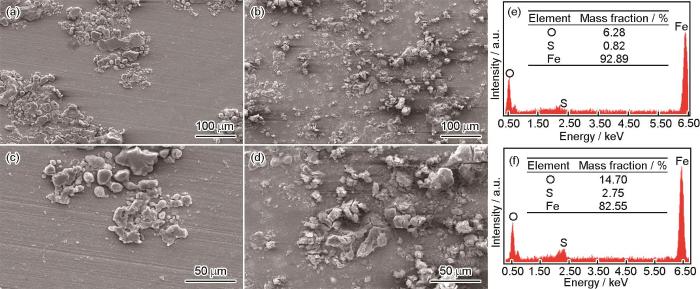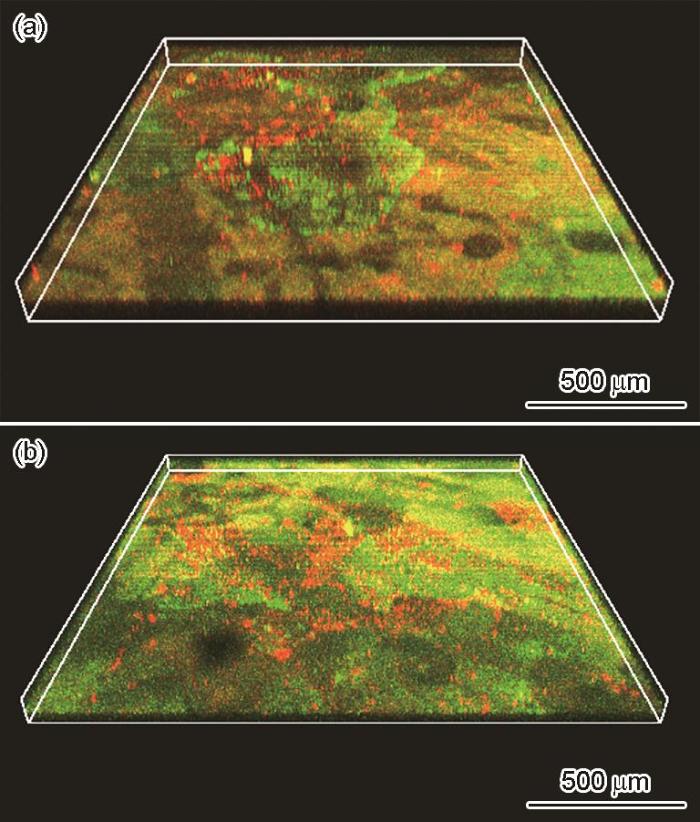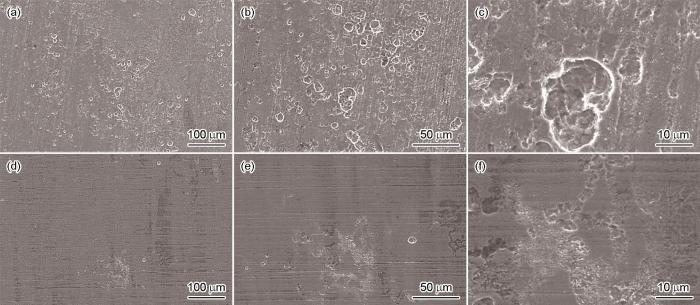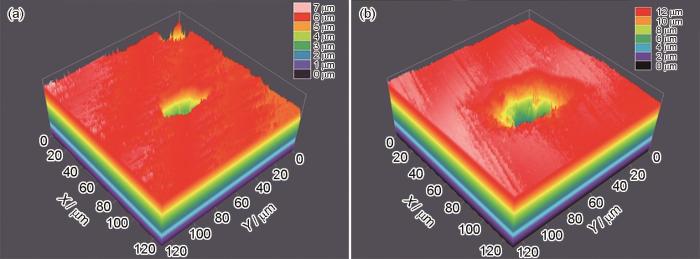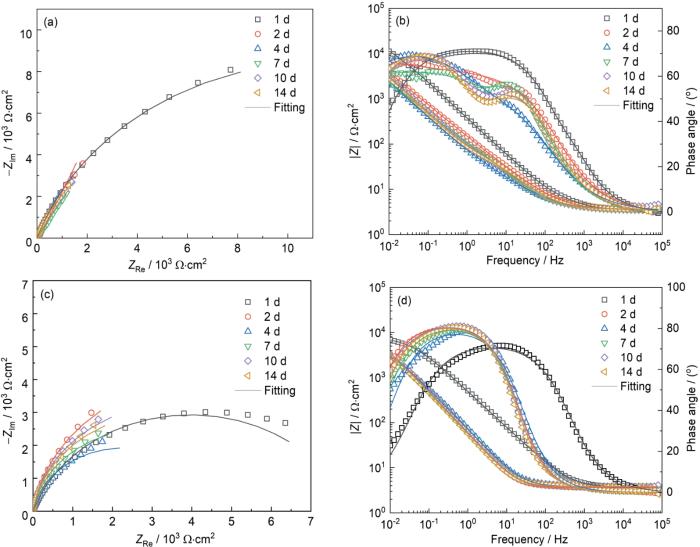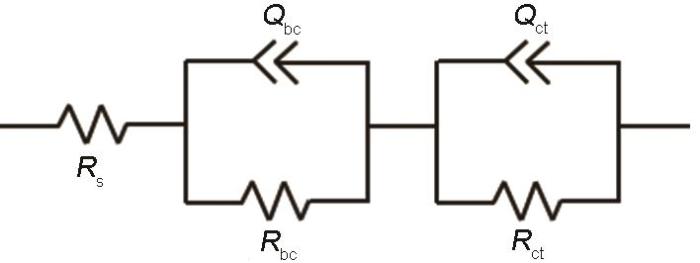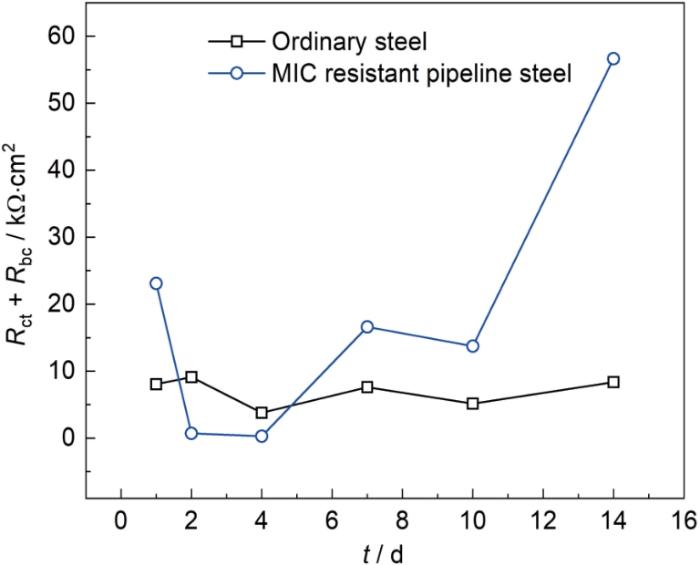Research progress of microbial corrosion of metallic materials in marine environment
1
2025
... 微生物腐蚀(Microbiologically influenced corrosion,MIC)是油气管道腐蚀失效的主要原因,以硫酸盐还原菌(SRB)、铁氧化菌(IOB)和产酸菌(APB)为代表的腐蚀微生物通过形成生物膜、分泌硫化氢、有机酸等代谢产物或直接电子传递参与腐蚀过程,导致异常严重的点蚀、应力腐蚀开裂,给油气生产造成巨大的经济损失和安全隐患[1].有统计表明,石油工业约75%的油井腐蚀及50%的埋地管道腐蚀由微生物造成[2].据美国管道和危险材料安全管理局(PHMSA)统计,近10 a累计有503起管道的内腐蚀事件是由MIC造成的. ...
海洋环境中金属材料微生物腐蚀研究进展
1
2025
... 微生物腐蚀(Microbiologically influenced corrosion,MIC)是油气管道腐蚀失效的主要原因,以硫酸盐还原菌(SRB)、铁氧化菌(IOB)和产酸菌(APB)为代表的腐蚀微生物通过形成生物膜、分泌硫化氢、有机酸等代谢产物或直接电子传递参与腐蚀过程,导致异常严重的点蚀、应力腐蚀开裂,给油气生产造成巨大的经济损失和安全隐患[1].有统计表明,石油工业约75%的油井腐蚀及50%的埋地管道腐蚀由微生物造成[2].据美国管道和危险材料安全管理局(PHMSA)统计,近10 a累计有503起管道的内腐蚀事件是由MIC造成的. ...
Microbial corrosion of polymer flooding oil gathering/transportation pipeline
1
2025
... 微生物腐蚀(Microbiologically influenced corrosion,MIC)是油气管道腐蚀失效的主要原因,以硫酸盐还原菌(SRB)、铁氧化菌(IOB)和产酸菌(APB)为代表的腐蚀微生物通过形成生物膜、分泌硫化氢、有机酸等代谢产物或直接电子传递参与腐蚀过程,导致异常严重的点蚀、应力腐蚀开裂,给油气生产造成巨大的经济损失和安全隐患[1].有统计表明,石油工业约75%的油井腐蚀及50%的埋地管道腐蚀由微生物造成[2].据美国管道和危险材料安全管理局(PHMSA)统计,近10 a累计有503起管道的内腐蚀事件是由MIC造成的. ...
聚合物驱集输管道微生物腐蚀行为实验研究
1
2025
... 微生物腐蚀(Microbiologically influenced corrosion,MIC)是油气管道腐蚀失效的主要原因,以硫酸盐还原菌(SRB)、铁氧化菌(IOB)和产酸菌(APB)为代表的腐蚀微生物通过形成生物膜、分泌硫化氢、有机酸等代谢产物或直接电子传递参与腐蚀过程,导致异常严重的点蚀、应力腐蚀开裂,给油气生产造成巨大的经济损失和安全隐患[1].有统计表明,石油工业约75%的油井腐蚀及50%的埋地管道腐蚀由微生物造成[2].据美国管道和危险材料安全管理局(PHMSA)统计,近10 a累计有503起管道的内腐蚀事件是由MIC造成的. ...
Novel Cu-bearing pipeline steels: a new strategy to improve resistance to microbiologically influenced corrosion for pipeline steels
1
2020
... 开发和使用抗菌管线钢是解决微生物腐蚀问题的有效途径之一.通过在管线钢中加入一定比例的抗菌合金元素(如Cu、Ag等),赋予其抗菌性能,成为抑制微生物腐蚀的新思路.目前,中国科学院金属研究所、衡阳钢管和上海宝钢等机构均有开展耐微生物腐蚀(MIC)管线钢材料研究开发和推广应用工作[3~7].Cu2+可通过破坏微生物细胞膜和DNA复制机制,使材料具有一定耐MIC性能,可作为关键合金元素加入管线钢中,同时适当调整Cr、Ni等元素含量,进一步优化管道钢的综合性能[8].其中,Cr在钢表面形成的富铬层也可以有效阻止微生物腐蚀的发生,Cr和Cu协同提高管道钢耐微生物腐蚀性能[9].于浩波等[10]在L245NCS管线钢中添加0.61% (质量分数,下同)的Cu,含Cu管线钢显著减弱了细菌的生长活性,抑制了点蚀发生,降低腐蚀速率.曾云鹏等[11]研究表明,Cu显著提高了管线钢的耐微生物腐蚀性能.Cu的含量对其耐微生物腐蚀性能具有重要影响.Cu含量越高耐蚀性能越强,在含SRB环境下,当Cu含量达到1.34%时可显著抑制管线钢的微生物腐蚀.尽管含Cu管线钢的抗菌性能已被广泛认可,但现有研究仍存在显著局限.单一依赖Cu抗菌的普适性方案难以兼顾材料加工性能,当Cu含量超过1.0%时,可能形成析出相,影响钢的加工性能,如焊接性.当Cu含量从1.0%提高到2.0%时其-20 ℃的冲击功将降低2/3[12].传统防腐策略侧重单一功能优化,忽视环境适应性需求.微生物腐蚀涉及多因素耦合作用,仅通过单一元素改性难以实现长效防护. ...
新型含Cu管线钢——提高管线耐微生物腐蚀性能的新途径
1
2020
... 开发和使用抗菌管线钢是解决微生物腐蚀问题的有效途径之一.通过在管线钢中加入一定比例的抗菌合金元素(如Cu、Ag等),赋予其抗菌性能,成为抑制微生物腐蚀的新思路.目前,中国科学院金属研究所、衡阳钢管和上海宝钢等机构均有开展耐微生物腐蚀(MIC)管线钢材料研究开发和推广应用工作[3~7].Cu2+可通过破坏微生物细胞膜和DNA复制机制,使材料具有一定耐MIC性能,可作为关键合金元素加入管线钢中,同时适当调整Cr、Ni等元素含量,进一步优化管道钢的综合性能[8].其中,Cr在钢表面形成的富铬层也可以有效阻止微生物腐蚀的发生,Cr和Cu协同提高管道钢耐微生物腐蚀性能[9].于浩波等[10]在L245NCS管线钢中添加0.61% (质量分数,下同)的Cu,含Cu管线钢显著减弱了细菌的生长活性,抑制了点蚀发生,降低腐蚀速率.曾云鹏等[11]研究表明,Cu显著提高了管线钢的耐微生物腐蚀性能.Cu的含量对其耐微生物腐蚀性能具有重要影响.Cu含量越高耐蚀性能越强,在含SRB环境下,当Cu含量达到1.34%时可显著抑制管线钢的微生物腐蚀.尽管含Cu管线钢的抗菌性能已被广泛认可,但现有研究仍存在显著局限.单一依赖Cu抗菌的普适性方案难以兼顾材料加工性能,当Cu含量超过1.0%时,可能形成析出相,影响钢的加工性能,如焊接性.当Cu含量从1.0%提高到2.0%时其-20 ℃的冲击功将降低2/3[12].传统防腐策略侧重单一功能优化,忽视环境适应性需求.微生物腐蚀涉及多因素耦合作用,仅通过单一元素改性难以实现长效防护. ...
Study on microbiologically influenced corrosion behavior of novel Cu-bearing pipeline steels
0
2017
新型含Cu管线钢的微生物腐蚀行为研究
0
2017
Study on microbiologically influenced corrosion of HSLA-65 steel
0
2024
Properties and application of antibacterial stainless steels
0
Microbiologically influenced corrosion of Cu-bearing steel welded joints for petroleum pipes
1
2025
... 开发和使用抗菌管线钢是解决微生物腐蚀问题的有效途径之一.通过在管线钢中加入一定比例的抗菌合金元素(如Cu、Ag等),赋予其抗菌性能,成为抑制微生物腐蚀的新思路.目前,中国科学院金属研究所、衡阳钢管和上海宝钢等机构均有开展耐微生物腐蚀(MIC)管线钢材料研究开发和推广应用工作[3~7].Cu2+可通过破坏微生物细胞膜和DNA复制机制,使材料具有一定耐MIC性能,可作为关键合金元素加入管线钢中,同时适当调整Cr、Ni等元素含量,进一步优化管道钢的综合性能[8].其中,Cr在钢表面形成的富铬层也可以有效阻止微生物腐蚀的发生,Cr和Cu协同提高管道钢耐微生物腐蚀性能[9].于浩波等[10]在L245NCS管线钢中添加0.61% (质量分数,下同)的Cu,含Cu管线钢显著减弱了细菌的生长活性,抑制了点蚀发生,降低腐蚀速率.曾云鹏等[11]研究表明,Cu显著提高了管线钢的耐微生物腐蚀性能.Cu的含量对其耐微生物腐蚀性能具有重要影响.Cu含量越高耐蚀性能越强,在含SRB环境下,当Cu含量达到1.34%时可显著抑制管线钢的微生物腐蚀.尽管含Cu管线钢的抗菌性能已被广泛认可,但现有研究仍存在显著局限.单一依赖Cu抗菌的普适性方案难以兼顾材料加工性能,当Cu含量超过1.0%时,可能形成析出相,影响钢的加工性能,如焊接性.当Cu含量从1.0%提高到2.0%时其-20 ℃的冲击功将降低2/3[12].传统防腐策略侧重单一功能优化,忽视环境适应性需求.微生物腐蚀涉及多因素耦合作用,仅通过单一元素改性难以实现长效防护. ...
石油管材用含Cu钢焊接接头的微生物腐蚀研究
1
2025
... 开发和使用抗菌管线钢是解决微生物腐蚀问题的有效途径之一.通过在管线钢中加入一定比例的抗菌合金元素(如Cu、Ag等),赋予其抗菌性能,成为抑制微生物腐蚀的新思路.目前,中国科学院金属研究所、衡阳钢管和上海宝钢等机构均有开展耐微生物腐蚀(MIC)管线钢材料研究开发和推广应用工作[3~7].Cu2+可通过破坏微生物细胞膜和DNA复制机制,使材料具有一定耐MIC性能,可作为关键合金元素加入管线钢中,同时适当调整Cr、Ni等元素含量,进一步优化管道钢的综合性能[8].其中,Cr在钢表面形成的富铬层也可以有效阻止微生物腐蚀的发生,Cr和Cu协同提高管道钢耐微生物腐蚀性能[9].于浩波等[10]在L245NCS管线钢中添加0.61% (质量分数,下同)的Cu,含Cu管线钢显著减弱了细菌的生长活性,抑制了点蚀发生,降低腐蚀速率.曾云鹏等[11]研究表明,Cu显著提高了管线钢的耐微生物腐蚀性能.Cu的含量对其耐微生物腐蚀性能具有重要影响.Cu含量越高耐蚀性能越强,在含SRB环境下,当Cu含量达到1.34%时可显著抑制管线钢的微生物腐蚀.尽管含Cu管线钢的抗菌性能已被广泛认可,但现有研究仍存在显著局限.单一依赖Cu抗菌的普适性方案难以兼顾材料加工性能,当Cu含量超过1.0%时,可能形成析出相,影响钢的加工性能,如焊接性.当Cu含量从1.0%提高到2.0%时其-20 ℃的冲击功将降低2/3[12].传统防腐策略侧重单一功能优化,忽视环境适应性需求.微生物腐蚀涉及多因素耦合作用,仅通过单一元素改性难以实现长效防护. ...
Copper alloying improves the microbiologically influenced corrosion resistance of pipeline steel
1
2024
... 开发和使用抗菌管线钢是解决微生物腐蚀问题的有效途径之一.通过在管线钢中加入一定比例的抗菌合金元素(如Cu、Ag等),赋予其抗菌性能,成为抑制微生物腐蚀的新思路.目前,中国科学院金属研究所、衡阳钢管和上海宝钢等机构均有开展耐微生物腐蚀(MIC)管线钢材料研究开发和推广应用工作[3~7].Cu2+可通过破坏微生物细胞膜和DNA复制机制,使材料具有一定耐MIC性能,可作为关键合金元素加入管线钢中,同时适当调整Cr、Ni等元素含量,进一步优化管道钢的综合性能[8].其中,Cr在钢表面形成的富铬层也可以有效阻止微生物腐蚀的发生,Cr和Cu协同提高管道钢耐微生物腐蚀性能[9].于浩波等[10]在L245NCS管线钢中添加0.61% (质量分数,下同)的Cu,含Cu管线钢显著减弱了细菌的生长活性,抑制了点蚀发生,降低腐蚀速率.曾云鹏等[11]研究表明,Cu显著提高了管线钢的耐微生物腐蚀性能.Cu的含量对其耐微生物腐蚀性能具有重要影响.Cu含量越高耐蚀性能越强,在含SRB环境下,当Cu含量达到1.34%时可显著抑制管线钢的微生物腐蚀.尽管含Cu管线钢的抗菌性能已被广泛认可,但现有研究仍存在显著局限.单一依赖Cu抗菌的普适性方案难以兼顾材料加工性能,当Cu含量超过1.0%时,可能形成析出相,影响钢的加工性能,如焊接性.当Cu含量从1.0%提高到2.0%时其-20 ℃的冲击功将降低2/3[12].传统防腐策略侧重单一功能优化,忽视环境适应性需求.微生物腐蚀涉及多因素耦合作用,仅通过单一元素改性难以实现长效防护. ...
Microbiologically influenced corrosion of a novel pipeline steel containing Cu and Cr elements in the presence of Desulfovibrio vulgaris Hildenborough
1
2023
... 开发和使用抗菌管线钢是解决微生物腐蚀问题的有效途径之一.通过在管线钢中加入一定比例的抗菌合金元素(如Cu、Ag等),赋予其抗菌性能,成为抑制微生物腐蚀的新思路.目前,中国科学院金属研究所、衡阳钢管和上海宝钢等机构均有开展耐微生物腐蚀(MIC)管线钢材料研究开发和推广应用工作[3~7].Cu2+可通过破坏微生物细胞膜和DNA复制机制,使材料具有一定耐MIC性能,可作为关键合金元素加入管线钢中,同时适当调整Cr、Ni等元素含量,进一步优化管道钢的综合性能[8].其中,Cr在钢表面形成的富铬层也可以有效阻止微生物腐蚀的发生,Cr和Cu协同提高管道钢耐微生物腐蚀性能[9].于浩波等[10]在L245NCS管线钢中添加0.61% (质量分数,下同)的Cu,含Cu管线钢显著减弱了细菌的生长活性,抑制了点蚀发生,降低腐蚀速率.曾云鹏等[11]研究表明,Cu显著提高了管线钢的耐微生物腐蚀性能.Cu的含量对其耐微生物腐蚀性能具有重要影响.Cu含量越高耐蚀性能越强,在含SRB环境下,当Cu含量达到1.34%时可显著抑制管线钢的微生物腐蚀.尽管含Cu管线钢的抗菌性能已被广泛认可,但现有研究仍存在显著局限.单一依赖Cu抗菌的普适性方案难以兼顾材料加工性能,当Cu含量超过1.0%时,可能形成析出相,影响钢的加工性能,如焊接性.当Cu含量从1.0%提高到2.0%时其-20 ℃的冲击功将降低2/3[12].传统防腐策略侧重单一功能优化,忽视环境适应性需求.微生物腐蚀涉及多因素耦合作用,仅通过单一元素改性难以实现长效防护. ...
Anti microbiological corrosion performance of Cu-containing antibacterial pipeline steel
1
2020
... 开发和使用抗菌管线钢是解决微生物腐蚀问题的有效途径之一.通过在管线钢中加入一定比例的抗菌合金元素(如Cu、Ag等),赋予其抗菌性能,成为抑制微生物腐蚀的新思路.目前,中国科学院金属研究所、衡阳钢管和上海宝钢等机构均有开展耐微生物腐蚀(MIC)管线钢材料研究开发和推广应用工作[3~7].Cu2+可通过破坏微生物细胞膜和DNA复制机制,使材料具有一定耐MIC性能,可作为关键合金元素加入管线钢中,同时适当调整Cr、Ni等元素含量,进一步优化管道钢的综合性能[8].其中,Cr在钢表面形成的富铬层也可以有效阻止微生物腐蚀的发生,Cr和Cu协同提高管道钢耐微生物腐蚀性能[9].于浩波等[10]在L245NCS管线钢中添加0.61% (质量分数,下同)的Cu,含Cu管线钢显著减弱了细菌的生长活性,抑制了点蚀发生,降低腐蚀速率.曾云鹏等[11]研究表明,Cu显著提高了管线钢的耐微生物腐蚀性能.Cu的含量对其耐微生物腐蚀性能具有重要影响.Cu含量越高耐蚀性能越强,在含SRB环境下,当Cu含量达到1.34%时可显著抑制管线钢的微生物腐蚀.尽管含Cu管线钢的抗菌性能已被广泛认可,但现有研究仍存在显著局限.单一依赖Cu抗菌的普适性方案难以兼顾材料加工性能,当Cu含量超过1.0%时,可能形成析出相,影响钢的加工性能,如焊接性.当Cu含量从1.0%提高到2.0%时其-20 ℃的冲击功将降低2/3[12].传统防腐策略侧重单一功能优化,忽视环境适应性需求.微生物腐蚀涉及多因素耦合作用,仅通过单一元素改性难以实现长效防护. ...
含Cu抗菌管线钢的抑制微生物腐蚀性能
1
2020
... 开发和使用抗菌管线钢是解决微生物腐蚀问题的有效途径之一.通过在管线钢中加入一定比例的抗菌合金元素(如Cu、Ag等),赋予其抗菌性能,成为抑制微生物腐蚀的新思路.目前,中国科学院金属研究所、衡阳钢管和上海宝钢等机构均有开展耐微生物腐蚀(MIC)管线钢材料研究开发和推广应用工作[3~7].Cu2+可通过破坏微生物细胞膜和DNA复制机制,使材料具有一定耐MIC性能,可作为关键合金元素加入管线钢中,同时适当调整Cr、Ni等元素含量,进一步优化管道钢的综合性能[8].其中,Cr在钢表面形成的富铬层也可以有效阻止微生物腐蚀的发生,Cr和Cu协同提高管道钢耐微生物腐蚀性能[9].于浩波等[10]在L245NCS管线钢中添加0.61% (质量分数,下同)的Cu,含Cu管线钢显著减弱了细菌的生长活性,抑制了点蚀发生,降低腐蚀速率.曾云鹏等[11]研究表明,Cu显著提高了管线钢的耐微生物腐蚀性能.Cu的含量对其耐微生物腐蚀性能具有重要影响.Cu含量越高耐蚀性能越强,在含SRB环境下,当Cu含量达到1.34%时可显著抑制管线钢的微生物腐蚀.尽管含Cu管线钢的抗菌性能已被广泛认可,但现有研究仍存在显著局限.单一依赖Cu抗菌的普适性方案难以兼顾材料加工性能,当Cu含量超过1.0%时,可能形成析出相,影响钢的加工性能,如焊接性.当Cu含量从1.0%提高到2.0%时其-20 ℃的冲击功将降低2/3[12].传统防腐策略侧重单一功能优化,忽视环境适应性需求.微生物腐蚀涉及多因素耦合作用,仅通过单一元素改性难以实现长效防护. ...
Effect of copper content on the MIC resistance in pipeline steel
1
2024
... 开发和使用抗菌管线钢是解决微生物腐蚀问题的有效途径之一.通过在管线钢中加入一定比例的抗菌合金元素(如Cu、Ag等),赋予其抗菌性能,成为抑制微生物腐蚀的新思路.目前,中国科学院金属研究所、衡阳钢管和上海宝钢等机构均有开展耐微生物腐蚀(MIC)管线钢材料研究开发和推广应用工作[3~7].Cu2+可通过破坏微生物细胞膜和DNA复制机制,使材料具有一定耐MIC性能,可作为关键合金元素加入管线钢中,同时适当调整Cr、Ni等元素含量,进一步优化管道钢的综合性能[8].其中,Cr在钢表面形成的富铬层也可以有效阻止微生物腐蚀的发生,Cr和Cu协同提高管道钢耐微生物腐蚀性能[9].于浩波等[10]在L245NCS管线钢中添加0.61% (质量分数,下同)的Cu,含Cu管线钢显著减弱了细菌的生长活性,抑制了点蚀发生,降低腐蚀速率.曾云鹏等[11]研究表明,Cu显著提高了管线钢的耐微生物腐蚀性能.Cu的含量对其耐微生物腐蚀性能具有重要影响.Cu含量越高耐蚀性能越强,在含SRB环境下,当Cu含量达到1.34%时可显著抑制管线钢的微生物腐蚀.尽管含Cu管线钢的抗菌性能已被广泛认可,但现有研究仍存在显著局限.单一依赖Cu抗菌的普适性方案难以兼顾材料加工性能,当Cu含量超过1.0%时,可能形成析出相,影响钢的加工性能,如焊接性.当Cu含量从1.0%提高到2.0%时其-20 ℃的冲击功将降低2/3[12].传统防腐策略侧重单一功能优化,忽视环境适应性需求.微生物腐蚀涉及多因素耦合作用,仅通过单一元素改性难以实现长效防护. ...
Cu含量对管线钢耐微生物腐蚀性能的影响
1
2024
... 开发和使用抗菌管线钢是解决微生物腐蚀问题的有效途径之一.通过在管线钢中加入一定比例的抗菌合金元素(如Cu、Ag等),赋予其抗菌性能,成为抑制微生物腐蚀的新思路.目前,中国科学院金属研究所、衡阳钢管和上海宝钢等机构均有开展耐微生物腐蚀(MIC)管线钢材料研究开发和推广应用工作[3~7].Cu2+可通过破坏微生物细胞膜和DNA复制机制,使材料具有一定耐MIC性能,可作为关键合金元素加入管线钢中,同时适当调整Cr、Ni等元素含量,进一步优化管道钢的综合性能[8].其中,Cr在钢表面形成的富铬层也可以有效阻止微生物腐蚀的发生,Cr和Cu协同提高管道钢耐微生物腐蚀性能[9].于浩波等[10]在L245NCS管线钢中添加0.61% (质量分数,下同)的Cu,含Cu管线钢显著减弱了细菌的生长活性,抑制了点蚀发生,降低腐蚀速率.曾云鹏等[11]研究表明,Cu显著提高了管线钢的耐微生物腐蚀性能.Cu的含量对其耐微生物腐蚀性能具有重要影响.Cu含量越高耐蚀性能越强,在含SRB环境下,当Cu含量达到1.34%时可显著抑制管线钢的微生物腐蚀.尽管含Cu管线钢的抗菌性能已被广泛认可,但现有研究仍存在显著局限.单一依赖Cu抗菌的普适性方案难以兼顾材料加工性能,当Cu含量超过1.0%时,可能形成析出相,影响钢的加工性能,如焊接性.当Cu含量从1.0%提高到2.0%时其-20 ℃的冲击功将降低2/3[12].传统防腐策略侧重单一功能优化,忽视环境适应性需求.微生物腐蚀涉及多因素耦合作用,仅通过单一元素改性难以实现长效防护. ...
Microbial corrosion resistance of a novel Cu-bearing pipeline steel
1
2018
... 开发和使用抗菌管线钢是解决微生物腐蚀问题的有效途径之一.通过在管线钢中加入一定比例的抗菌合金元素(如Cu、Ag等),赋予其抗菌性能,成为抑制微生物腐蚀的新思路.目前,中国科学院金属研究所、衡阳钢管和上海宝钢等机构均有开展耐微生物腐蚀(MIC)管线钢材料研究开发和推广应用工作[3~7].Cu2+可通过破坏微生物细胞膜和DNA复制机制,使材料具有一定耐MIC性能,可作为关键合金元素加入管线钢中,同时适当调整Cr、Ni等元素含量,进一步优化管道钢的综合性能[8].其中,Cr在钢表面形成的富铬层也可以有效阻止微生物腐蚀的发生,Cr和Cu协同提高管道钢耐微生物腐蚀性能[9].于浩波等[10]在L245NCS管线钢中添加0.61% (质量分数,下同)的Cu,含Cu管线钢显著减弱了细菌的生长活性,抑制了点蚀发生,降低腐蚀速率.曾云鹏等[11]研究表明,Cu显著提高了管线钢的耐微生物腐蚀性能.Cu的含量对其耐微生物腐蚀性能具有重要影响.Cu含量越高耐蚀性能越强,在含SRB环境下,当Cu含量达到1.34%时可显著抑制管线钢的微生物腐蚀.尽管含Cu管线钢的抗菌性能已被广泛认可,但现有研究仍存在显著局限.单一依赖Cu抗菌的普适性方案难以兼顾材料加工性能,当Cu含量超过1.0%时,可能形成析出相,影响钢的加工性能,如焊接性.当Cu含量从1.0%提高到2.0%时其-20 ℃的冲击功将降低2/3[12].传统防腐策略侧重单一功能优化,忽视环境适应性需求.微生物腐蚀涉及多因素耦合作用,仅通过单一元素改性难以实现长效防护. ...
SRB-mediated corrosion of marine submerged AISI 1020 steel under impressed current cathodic protection
1
2021
... 耐MIC钢和普通钢两种试样表面腐蚀产物的Raman图谱(图3)显示,680 cm-1附近的谱峰为Fe3O4,390和1300 cm-1附近为α-FeOOH,215和280 cm-1附近为FeS,1080 cm-1附近为FeCO3.由此可知,在SRB腐蚀过程中,SO被还原产生腐蚀性的HS-,导致FeS在腐蚀产物中沉积.部分SRB可以直接从Fe0中获得电子[13,14],使Fe0转换为Fe2+.普通钢和耐MIC钢的最强Raman光谱峰分别为Fe3O4和α-FeOOH.通常情况下,FeOOH由α-FeOOH、β-FeOOH、γ-FeOOH组成,其中α-FeOOH晶体枝晶纤细、结构致密,这种致密的结构可以阻止外界的腐蚀性介质向金属基体渗入减缓耐MIC钢的腐蚀速度,是最稳定的能抑制腐蚀的组分;而不稳定的γ-FeOOH和β-FeOOH极易转化为Fe3O4[15,16].Fe3O4结构疏松,腐蚀性介质更容易通过其结构中的孔隙渗透到金属基体表面,同时Fe3O4易与H+ [17]发生反应,使产物膜的离子渗透性降低. ...
Synergistic inhibition of rhamnolipid and 2, 2-dibromo-3-hypoazopropionamide on microbiologically influenced corrosion of X80 pipeline steel
1
2024
... 耐MIC钢和普通钢两种试样表面腐蚀产物的Raman图谱(图3)显示,680 cm-1附近的谱峰为Fe3O4,390和1300 cm-1附近为α-FeOOH,215和280 cm-1附近为FeS,1080 cm-1附近为FeCO3.由此可知,在SRB腐蚀过程中,SO被还原产生腐蚀性的HS-,导致FeS在腐蚀产物中沉积.部分SRB可以直接从Fe0中获得电子[13,14],使Fe0转换为Fe2+.普通钢和耐MIC钢的最强Raman光谱峰分别为Fe3O4和α-FeOOH.通常情况下,FeOOH由α-FeOOH、β-FeOOH、γ-FeOOH组成,其中α-FeOOH晶体枝晶纤细、结构致密,这种致密的结构可以阻止外界的腐蚀性介质向金属基体渗入减缓耐MIC钢的腐蚀速度,是最稳定的能抑制腐蚀的组分;而不稳定的γ-FeOOH和β-FeOOH极易转化为Fe3O4[15,16].Fe3O4结构疏松,腐蚀性介质更容易通过其结构中的孔隙渗透到金属基体表面,同时Fe3O4易与H+ [17]发生反应,使产物膜的离子渗透性降低. ...
鼠李糖脂与2,2-二溴-3-次氮基丙酰胺协同抑制X80管线钢的微生物腐蚀
1
2024
... 耐MIC钢和普通钢两种试样表面腐蚀产物的Raman图谱(图3)显示,680 cm-1附近的谱峰为Fe3O4,390和1300 cm-1附近为α-FeOOH,215和280 cm-1附近为FeS,1080 cm-1附近为FeCO3.由此可知,在SRB腐蚀过程中,SO被还原产生腐蚀性的HS-,导致FeS在腐蚀产物中沉积.部分SRB可以直接从Fe0中获得电子[13,14],使Fe0转换为Fe2+.普通钢和耐MIC钢的最强Raman光谱峰分别为Fe3O4和α-FeOOH.通常情况下,FeOOH由α-FeOOH、β-FeOOH、γ-FeOOH组成,其中α-FeOOH晶体枝晶纤细、结构致密,这种致密的结构可以阻止外界的腐蚀性介质向金属基体渗入减缓耐MIC钢的腐蚀速度,是最稳定的能抑制腐蚀的组分;而不稳定的γ-FeOOH和β-FeOOH极易转化为Fe3O4[15,16].Fe3O4结构疏松,腐蚀性介质更容易通过其结构中的孔隙渗透到金属基体表面,同时Fe3O4易与H+ [17]发生反应,使产物膜的离子渗透性降低. ...
Corrosion resistance and biocompatibility of calcium-containing coatings developed in near-neutral solutions containing phytic acid and phosphoric acid on AZ31B alloy
1
2020
... 耐MIC钢和普通钢两种试样表面腐蚀产物的Raman图谱(图3)显示,680 cm-1附近的谱峰为Fe3O4,390和1300 cm-1附近为α-FeOOH,215和280 cm-1附近为FeS,1080 cm-1附近为FeCO3.由此可知,在SRB腐蚀过程中,SO被还原产生腐蚀性的HS-,导致FeS在腐蚀产物中沉积.部分SRB可以直接从Fe0中获得电子[13,14],使Fe0转换为Fe2+.普通钢和耐MIC钢的最强Raman光谱峰分别为Fe3O4和α-FeOOH.通常情况下,FeOOH由α-FeOOH、β-FeOOH、γ-FeOOH组成,其中α-FeOOH晶体枝晶纤细、结构致密,这种致密的结构可以阻止外界的腐蚀性介质向金属基体渗入减缓耐MIC钢的腐蚀速度,是最稳定的能抑制腐蚀的组分;而不稳定的γ-FeOOH和β-FeOOH极易转化为Fe3O4[15,16].Fe3O4结构疏松,腐蚀性介质更容易通过其结构中的孔隙渗透到金属基体表面,同时Fe3O4易与H+ [17]发生反应,使产物膜的离子渗透性降低. ...
Corrosion behavior of high entropy alloy FeNiCoCrW0.2Al0.1 in sulfate-reducing bacteria containing solution
1
2025
... 耐MIC钢和普通钢两种试样表面腐蚀产物的Raman图谱(图3)显示,680 cm-1附近的谱峰为Fe3O4,390和1300 cm-1附近为α-FeOOH,215和280 cm-1附近为FeS,1080 cm-1附近为FeCO3.由此可知,在SRB腐蚀过程中,SO被还原产生腐蚀性的HS-,导致FeS在腐蚀产物中沉积.部分SRB可以直接从Fe0中获得电子[13,14],使Fe0转换为Fe2+.普通钢和耐MIC钢的最强Raman光谱峰分别为Fe3O4和α-FeOOH.通常情况下,FeOOH由α-FeOOH、β-FeOOH、γ-FeOOH组成,其中α-FeOOH晶体枝晶纤细、结构致密,这种致密的结构可以阻止外界的腐蚀性介质向金属基体渗入减缓耐MIC钢的腐蚀速度,是最稳定的能抑制腐蚀的组分;而不稳定的γ-FeOOH和β-FeOOH极易转化为Fe3O4[15,16].Fe3O4结构疏松,腐蚀性介质更容易通过其结构中的孔隙渗透到金属基体表面,同时Fe3O4易与H+ [17]发生反应,使产物膜的离子渗透性降低. ...
FeNiCoCrW0.2Al0.1高熵合金在硫酸盐还原菌溶液环境下的腐蚀研究
1
2025
... 耐MIC钢和普通钢两种试样表面腐蚀产物的Raman图谱(图3)显示,680 cm-1附近的谱峰为Fe3O4,390和1300 cm-1附近为α-FeOOH,215和280 cm-1附近为FeS,1080 cm-1附近为FeCO3.由此可知,在SRB腐蚀过程中,SO被还原产生腐蚀性的HS-,导致FeS在腐蚀产物中沉积.部分SRB可以直接从Fe0中获得电子[13,14],使Fe0转换为Fe2+.普通钢和耐MIC钢的最强Raman光谱峰分别为Fe3O4和α-FeOOH.通常情况下,FeOOH由α-FeOOH、β-FeOOH、γ-FeOOH组成,其中α-FeOOH晶体枝晶纤细、结构致密,这种致密的结构可以阻止外界的腐蚀性介质向金属基体渗入减缓耐MIC钢的腐蚀速度,是最稳定的能抑制腐蚀的组分;而不稳定的γ-FeOOH和β-FeOOH极易转化为Fe3O4[15,16].Fe3O4结构疏松,腐蚀性介质更容易通过其结构中的孔隙渗透到金属基体表面,同时Fe3O4易与H+ [17]发生反应,使产物膜的离子渗透性降低. ...
Effect of crevice morphology on SRB activity and steel corrosion under marine foulers
1
2021
... 耐MIC钢和普通钢两种试样表面腐蚀产物的Raman图谱(图3)显示,680 cm-1附近的谱峰为Fe3O4,390和1300 cm-1附近为α-FeOOH,215和280 cm-1附近为FeS,1080 cm-1附近为FeCO3.由此可知,在SRB腐蚀过程中,SO被还原产生腐蚀性的HS-,导致FeS在腐蚀产物中沉积.部分SRB可以直接从Fe0中获得电子[13,14],使Fe0转换为Fe2+.普通钢和耐MIC钢的最强Raman光谱峰分别为Fe3O4和α-FeOOH.通常情况下,FeOOH由α-FeOOH、β-FeOOH、γ-FeOOH组成,其中α-FeOOH晶体枝晶纤细、结构致密,这种致密的结构可以阻止外界的腐蚀性介质向金属基体渗入减缓耐MIC钢的腐蚀速度,是最稳定的能抑制腐蚀的组分;而不稳定的γ-FeOOH和β-FeOOH极易转化为Fe3O4[15,16].Fe3O4结构疏松,腐蚀性介质更容易通过其结构中的孔隙渗透到金属基体表面,同时Fe3O4易与H+ [17]发生反应,使产物膜的离子渗透性降低. ...
Enhanced the SRB corrosion resistance of 316L stainless steel via adjusting the addition of Cu and Ce elements
1
2024
... Cu可抑制管道钢表面SRB的生长及生物膜的形成.一方面,含Cu钢表面在环境介质中释放Cu2+ [18].Cu2+可与微生物细胞膜上带负电基团(如磷脂、蛋白质等)结合,减少生物膜中的蛋白质和多糖含量,改变蛋白质的结构和功能,增加细胞膜的通透性,使细胞内的物质外流,导致细胞死亡[19].Cu2+进入细菌会促进过氧化氢(H2O2)、超氧阴离子(O)、羟基自由基(-OH)等活性氧离子的产生[20],这些活性氧离子攻击细胞内结构,氧化氨基酸、碳水化合物、RNA等,引发脂质过氧化,使DNA突变并产生遗传毒性[21~23],通过氧化应激导致细菌正常细胞功能丧失和死亡.Cu2+还可以通过损坏细胞质酶中支链氨基酸所必需的Fe-S集群[24],导致蛋白质和酶的功能丧失.同时,SRB代谢产生的S2-会优先与耐MIC钢表面释放的Cu2+发生反应,生成CuS,随着Cu2+被消耗,抗菌效果减弱.另一方面,含Cu相的静电相互作用,扰乱细胞内外渗透压的平衡[25],使细胞膜上膜蛋白和离子通道受到破化,细胞壁中的肽聚糖层消失,引起细菌的生理代谢紊乱,细胞膜与细胞壁分离、分解,从而导致细胞质泄漏[26~29].Zhang等[30]的研究表明,富Cu相和不锈钢基体之间的电位差约为40 mV,在富Cu相附近溶液中会形成微原电池并产生电荷转移.细菌细胞膜中呼吸链通过递氢反应和递电子反应进行一系列的电子转移,以此合成三磷酸腺苷(ATP)[31,32].细菌与材料表面接触时,含Cu相与基体之间的电位差会消耗离子,同时电位差所诱导的电子转移干扰细菌的正常呼吸过程,使得ATP产生量减少,并加速细胞内活性氧的产生,引发细菌死亡[33~36]. ...
Antibacterial behavior and related mechanisms of martensitic Cu-bearing stainless steel evaluated by a mixed infection model of Escherichia coli and Staphylococcus aureus in vitro
1
2021
... Cu可抑制管道钢表面SRB的生长及生物膜的形成.一方面,含Cu钢表面在环境介质中释放Cu2+ [18].Cu2+可与微生物细胞膜上带负电基团(如磷脂、蛋白质等)结合,减少生物膜中的蛋白质和多糖含量,改变蛋白质的结构和功能,增加细胞膜的通透性,使细胞内的物质外流,导致细胞死亡[19].Cu2+进入细菌会促进过氧化氢(H2O2)、超氧阴离子(O)、羟基自由基(-OH)等活性氧离子的产生[20],这些活性氧离子攻击细胞内结构,氧化氨基酸、碳水化合物、RNA等,引发脂质过氧化,使DNA突变并产生遗传毒性[21~23],通过氧化应激导致细菌正常细胞功能丧失和死亡.Cu2+还可以通过损坏细胞质酶中支链氨基酸所必需的Fe-S集群[24],导致蛋白质和酶的功能丧失.同时,SRB代谢产生的S2-会优先与耐MIC钢表面释放的Cu2+发生反应,生成CuS,随着Cu2+被消耗,抗菌效果减弱.另一方面,含Cu相的静电相互作用,扰乱细胞内外渗透压的平衡[25],使细胞膜上膜蛋白和离子通道受到破化,细胞壁中的肽聚糖层消失,引起细菌的生理代谢紊乱,细胞膜与细胞壁分离、分解,从而导致细胞质泄漏[26~29].Zhang等[30]的研究表明,富Cu相和不锈钢基体之间的电位差约为40 mV,在富Cu相附近溶液中会形成微原电池并产生电荷转移.细菌细胞膜中呼吸链通过递氢反应和递电子反应进行一系列的电子转移,以此合成三磷酸腺苷(ATP)[31,32].细菌与材料表面接触时,含Cu相与基体之间的电位差会消耗离子,同时电位差所诱导的电子转移干扰细菌的正常呼吸过程,使得ATP产生量减少,并加速细胞内活性氧的产生,引发细菌死亡[33~36]. ...
Free radicals and oxidative stress in bacteria
1
2014
... Cu可抑制管道钢表面SRB的生长及生物膜的形成.一方面,含Cu钢表面在环境介质中释放Cu2+ [18].Cu2+可与微生物细胞膜上带负电基团(如磷脂、蛋白质等)结合,减少生物膜中的蛋白质和多糖含量,改变蛋白质的结构和功能,增加细胞膜的通透性,使细胞内的物质外流,导致细胞死亡[19].Cu2+进入细菌会促进过氧化氢(H2O2)、超氧阴离子(O)、羟基自由基(-OH)等活性氧离子的产生[20],这些活性氧离子攻击细胞内结构,氧化氨基酸、碳水化合物、RNA等,引发脂质过氧化,使DNA突变并产生遗传毒性[21~23],通过氧化应激导致细菌正常细胞功能丧失和死亡.Cu2+还可以通过损坏细胞质酶中支链氨基酸所必需的Fe-S集群[24],导致蛋白质和酶的功能丧失.同时,SRB代谢产生的S2-会优先与耐MIC钢表面释放的Cu2+发生反应,生成CuS,随着Cu2+被消耗,抗菌效果减弱.另一方面,含Cu相的静电相互作用,扰乱细胞内外渗透压的平衡[25],使细胞膜上膜蛋白和离子通道受到破化,细胞壁中的肽聚糖层消失,引起细菌的生理代谢紊乱,细胞膜与细胞壁分离、分解,从而导致细胞质泄漏[26~29].Zhang等[30]的研究表明,富Cu相和不锈钢基体之间的电位差约为40 mV,在富Cu相附近溶液中会形成微原电池并产生电荷转移.细菌细胞膜中呼吸链通过递氢反应和递电子反应进行一系列的电子转移,以此合成三磷酸腺苷(ATP)[31,32].细菌与材料表面接触时,含Cu相与基体之间的电位差会消耗离子,同时电位差所诱导的电子转移干扰细菌的正常呼吸过程,使得ATP产生量减少,并加速细胞内活性氧的产生,引发细菌死亡[33~36]. ...
Application of copper to prevent and control infection. Where are we now?
1
2012
... Cu可抑制管道钢表面SRB的生长及生物膜的形成.一方面,含Cu钢表面在环境介质中释放Cu2+ [18].Cu2+可与微生物细胞膜上带负电基团(如磷脂、蛋白质等)结合,减少生物膜中的蛋白质和多糖含量,改变蛋白质的结构和功能,增加细胞膜的通透性,使细胞内的物质外流,导致细胞死亡[19].Cu2+进入细菌会促进过氧化氢(H2O2)、超氧阴离子(O)、羟基自由基(-OH)等活性氧离子的产生[20],这些活性氧离子攻击细胞内结构,氧化氨基酸、碳水化合物、RNA等,引发脂质过氧化,使DNA突变并产生遗传毒性[21~23],通过氧化应激导致细菌正常细胞功能丧失和死亡.Cu2+还可以通过损坏细胞质酶中支链氨基酸所必需的Fe-S集群[24],导致蛋白质和酶的功能丧失.同时,SRB代谢产生的S2-会优先与耐MIC钢表面释放的Cu2+发生反应,生成CuS,随着Cu2+被消耗,抗菌效果减弱.另一方面,含Cu相的静电相互作用,扰乱细胞内外渗透压的平衡[25],使细胞膜上膜蛋白和离子通道受到破化,细胞壁中的肽聚糖层消失,引起细菌的生理代谢紊乱,细胞膜与细胞壁分离、分解,从而导致细胞质泄漏[26~29].Zhang等[30]的研究表明,富Cu相和不锈钢基体之间的电位差约为40 mV,在富Cu相附近溶液中会形成微原电池并产生电荷转移.细菌细胞膜中呼吸链通过递氢反应和递电子反应进行一系列的电子转移,以此合成三磷酸腺苷(ATP)[31,32].细菌与材料表面接触时,含Cu相与基体之间的电位差会消耗离子,同时电位差所诱导的电子转移干扰细菌的正常呼吸过程,使得ATP产生量减少,并加速细胞内活性氧的产生,引发细菌死亡[33~36]. ...
Study on the antibacterial mechanism of Cu-bearing titanium alloy in the view of materials science
0
2020
Effect of nano/micro-Ag compound particles on the bio-corrosion, antibacterial properties and cell biocompatibility of Ti-Ag alloys
1
2017
... Cu可抑制管道钢表面SRB的生长及生物膜的形成.一方面,含Cu钢表面在环境介质中释放Cu2+ [18].Cu2+可与微生物细胞膜上带负电基团(如磷脂、蛋白质等)结合,减少生物膜中的蛋白质和多糖含量,改变蛋白质的结构和功能,增加细胞膜的通透性,使细胞内的物质外流,导致细胞死亡[19].Cu2+进入细菌会促进过氧化氢(H2O2)、超氧阴离子(O)、羟基自由基(-OH)等活性氧离子的产生[20],这些活性氧离子攻击细胞内结构,氧化氨基酸、碳水化合物、RNA等,引发脂质过氧化,使DNA突变并产生遗传毒性[21~23],通过氧化应激导致细菌正常细胞功能丧失和死亡.Cu2+还可以通过损坏细胞质酶中支链氨基酸所必需的Fe-S集群[24],导致蛋白质和酶的功能丧失.同时,SRB代谢产生的S2-会优先与耐MIC钢表面释放的Cu2+发生反应,生成CuS,随着Cu2+被消耗,抗菌效果减弱.另一方面,含Cu相的静电相互作用,扰乱细胞内外渗透压的平衡[25],使细胞膜上膜蛋白和离子通道受到破化,细胞壁中的肽聚糖层消失,引起细菌的生理代谢紊乱,细胞膜与细胞壁分离、分解,从而导致细胞质泄漏[26~29].Zhang等[30]的研究表明,富Cu相和不锈钢基体之间的电位差约为40 mV,在富Cu相附近溶液中会形成微原电池并产生电荷转移.细菌细胞膜中呼吸链通过递氢反应和递电子反应进行一系列的电子转移,以此合成三磷酸腺苷(ATP)[31,32].细菌与材料表面接触时,含Cu相与基体之间的电位差会消耗离子,同时电位差所诱导的电子转移干扰细菌的正常呼吸过程,使得ATP产生量减少,并加速细胞内活性氧的产生,引发细菌死亡[33~36]. ...
The iron-sulfur clusters of dehydratases are primary intracellular targets of copper toxicity
1
2009
... Cu可抑制管道钢表面SRB的生长及生物膜的形成.一方面,含Cu钢表面在环境介质中释放Cu2+ [18].Cu2+可与微生物细胞膜上带负电基团(如磷脂、蛋白质等)结合,减少生物膜中的蛋白质和多糖含量,改变蛋白质的结构和功能,增加细胞膜的通透性,使细胞内的物质外流,导致细胞死亡[19].Cu2+进入细菌会促进过氧化氢(H2O2)、超氧阴离子(O)、羟基自由基(-OH)等活性氧离子的产生[20],这些活性氧离子攻击细胞内结构,氧化氨基酸、碳水化合物、RNA等,引发脂质过氧化,使DNA突变并产生遗传毒性[21~23],通过氧化应激导致细菌正常细胞功能丧失和死亡.Cu2+还可以通过损坏细胞质酶中支链氨基酸所必需的Fe-S集群[24],导致蛋白质和酶的功能丧失.同时,SRB代谢产生的S2-会优先与耐MIC钢表面释放的Cu2+发生反应,生成CuS,随着Cu2+被消耗,抗菌效果减弱.另一方面,含Cu相的静电相互作用,扰乱细胞内外渗透压的平衡[25],使细胞膜上膜蛋白和离子通道受到破化,细胞壁中的肽聚糖层消失,引起细菌的生理代谢紊乱,细胞膜与细胞壁分离、分解,从而导致细胞质泄漏[26~29].Zhang等[30]的研究表明,富Cu相和不锈钢基体之间的电位差约为40 mV,在富Cu相附近溶液中会形成微原电池并产生电荷转移.细菌细胞膜中呼吸链通过递氢反应和递电子反应进行一系列的电子转移,以此合成三磷酸腺苷(ATP)[31,32].细菌与材料表面接触时,含Cu相与基体之间的电位差会消耗离子,同时电位差所诱导的电子转移干扰细菌的正常呼吸过程,使得ATP产生量减少,并加速细胞内活性氧的产生,引发细菌死亡[33~36]. ...
Antibacterial Ti-Cu implants: A critical review on mechanisms of action
1
2022
... Cu可抑制管道钢表面SRB的生长及生物膜的形成.一方面,含Cu钢表面在环境介质中释放Cu2+ [18].Cu2+可与微生物细胞膜上带负电基团(如磷脂、蛋白质等)结合,减少生物膜中的蛋白质和多糖含量,改变蛋白质的结构和功能,增加细胞膜的通透性,使细胞内的物质外流,导致细胞死亡[19].Cu2+进入细菌会促进过氧化氢(H2O2)、超氧阴离子(O)、羟基自由基(-OH)等活性氧离子的产生[20],这些活性氧离子攻击细胞内结构,氧化氨基酸、碳水化合物、RNA等,引发脂质过氧化,使DNA突变并产生遗传毒性[21~23],通过氧化应激导致细菌正常细胞功能丧失和死亡.Cu2+还可以通过损坏细胞质酶中支链氨基酸所必需的Fe-S集群[24],导致蛋白质和酶的功能丧失.同时,SRB代谢产生的S2-会优先与耐MIC钢表面释放的Cu2+发生反应,生成CuS,随着Cu2+被消耗,抗菌效果减弱.另一方面,含Cu相的静电相互作用,扰乱细胞内外渗透压的平衡[25],使细胞膜上膜蛋白和离子通道受到破化,细胞壁中的肽聚糖层消失,引起细菌的生理代谢紊乱,细胞膜与细胞壁分离、分解,从而导致细胞质泄漏[26~29].Zhang等[30]的研究表明,富Cu相和不锈钢基体之间的电位差约为40 mV,在富Cu相附近溶液中会形成微原电池并产生电荷转移.细菌细胞膜中呼吸链通过递氢反应和递电子反应进行一系列的电子转移,以此合成三磷酸腺苷(ATP)[31,32].细菌与材料表面接触时,含Cu相与基体之间的电位差会消耗离子,同时电位差所诱导的电子转移干扰细菌的正常呼吸过程,使得ATP产生量减少,并加速细胞内活性氧的产生,引发细菌死亡[33~36]. ...
What controls the antibacterial activity of Ti-Ag alloy, Ag ion or Ti2Ag particles?
1
2020
... Cu可抑制管道钢表面SRB的生长及生物膜的形成.一方面,含Cu钢表面在环境介质中释放Cu2+ [18].Cu2+可与微生物细胞膜上带负电基团(如磷脂、蛋白质等)结合,减少生物膜中的蛋白质和多糖含量,改变蛋白质的结构和功能,增加细胞膜的通透性,使细胞内的物质外流,导致细胞死亡[19].Cu2+进入细菌会促进过氧化氢(H2O2)、超氧阴离子(O)、羟基自由基(-OH)等活性氧离子的产生[20],这些活性氧离子攻击细胞内结构,氧化氨基酸、碳水化合物、RNA等,引发脂质过氧化,使DNA突变并产生遗传毒性[21~23],通过氧化应激导致细菌正常细胞功能丧失和死亡.Cu2+还可以通过损坏细胞质酶中支链氨基酸所必需的Fe-S集群[24],导致蛋白质和酶的功能丧失.同时,SRB代谢产生的S2-会优先与耐MIC钢表面释放的Cu2+发生反应,生成CuS,随着Cu2+被消耗,抗菌效果减弱.另一方面,含Cu相的静电相互作用,扰乱细胞内外渗透压的平衡[25],使细胞膜上膜蛋白和离子通道受到破化,细胞壁中的肽聚糖层消失,引起细菌的生理代谢紊乱,细胞膜与细胞壁分离、分解,从而导致细胞质泄漏[26~29].Zhang等[30]的研究表明,富Cu相和不锈钢基体之间的电位差约为40 mV,在富Cu相附近溶液中会形成微原电池并产生电荷转移.细菌细胞膜中呼吸链通过递氢反应和递电子反应进行一系列的电子转移,以此合成三磷酸腺苷(ATP)[31,32].细菌与材料表面接触时,含Cu相与基体之间的电位差会消耗离子,同时电位差所诱导的电子转移干扰细菌的正常呼吸过程,使得ATP产生量减少,并加速细胞内活性氧的产生,引发细菌死亡[33~36]. ...
Study on antibacterial mechanism of copper-bearing austenitic antibacterial stainless steel by atomic force microscopy
0
2008
Toward a molecular understanding of the antibacterial mechanism of copper‐bearing titanium alloys against Staphylococcus aureus
0
2016
Research progress of metal corrosion caused by extracellular polymeric substances of microorganisms
1
2024
... Cu可抑制管道钢表面SRB的生长及生物膜的形成.一方面,含Cu钢表面在环境介质中释放Cu2+ [18].Cu2+可与微生物细胞膜上带负电基团(如磷脂、蛋白质等)结合,减少生物膜中的蛋白质和多糖含量,改变蛋白质的结构和功能,增加细胞膜的通透性,使细胞内的物质外流,导致细胞死亡[19].Cu2+进入细菌会促进过氧化氢(H2O2)、超氧阴离子(O)、羟基自由基(-OH)等活性氧离子的产生[20],这些活性氧离子攻击细胞内结构,氧化氨基酸、碳水化合物、RNA等,引发脂质过氧化,使DNA突变并产生遗传毒性[21~23],通过氧化应激导致细菌正常细胞功能丧失和死亡.Cu2+还可以通过损坏细胞质酶中支链氨基酸所必需的Fe-S集群[24],导致蛋白质和酶的功能丧失.同时,SRB代谢产生的S2-会优先与耐MIC钢表面释放的Cu2+发生反应,生成CuS,随着Cu2+被消耗,抗菌效果减弱.另一方面,含Cu相的静电相互作用,扰乱细胞内外渗透压的平衡[25],使细胞膜上膜蛋白和离子通道受到破化,细胞壁中的肽聚糖层消失,引起细菌的生理代谢紊乱,细胞膜与细胞壁分离、分解,从而导致细胞质泄漏[26~29].Zhang等[30]的研究表明,富Cu相和不锈钢基体之间的电位差约为40 mV,在富Cu相附近溶液中会形成微原电池并产生电荷转移.细菌细胞膜中呼吸链通过递氢反应和递电子反应进行一系列的电子转移,以此合成三磷酸腺苷(ATP)[31,32].细菌与材料表面接触时,含Cu相与基体之间的电位差会消耗离子,同时电位差所诱导的电子转移干扰细菌的正常呼吸过程,使得ATP产生量减少,并加速细胞内活性氧的产生,引发细菌死亡[33~36]. ...
微生物胞外聚合物引起的金属腐蚀的研究进展
1
2024
... Cu可抑制管道钢表面SRB的生长及生物膜的形成.一方面,含Cu钢表面在环境介质中释放Cu2+ [18].Cu2+可与微生物细胞膜上带负电基团(如磷脂、蛋白质等)结合,减少生物膜中的蛋白质和多糖含量,改变蛋白质的结构和功能,增加细胞膜的通透性,使细胞内的物质外流,导致细胞死亡[19].Cu2+进入细菌会促进过氧化氢(H2O2)、超氧阴离子(O)、羟基自由基(-OH)等活性氧离子的产生[20],这些活性氧离子攻击细胞内结构,氧化氨基酸、碳水化合物、RNA等,引发脂质过氧化,使DNA突变并产生遗传毒性[21~23],通过氧化应激导致细菌正常细胞功能丧失和死亡.Cu2+还可以通过损坏细胞质酶中支链氨基酸所必需的Fe-S集群[24],导致蛋白质和酶的功能丧失.同时,SRB代谢产生的S2-会优先与耐MIC钢表面释放的Cu2+发生反应,生成CuS,随着Cu2+被消耗,抗菌效果减弱.另一方面,含Cu相的静电相互作用,扰乱细胞内外渗透压的平衡[25],使细胞膜上膜蛋白和离子通道受到破化,细胞壁中的肽聚糖层消失,引起细菌的生理代谢紊乱,细胞膜与细胞壁分离、分解,从而导致细胞质泄漏[26~29].Zhang等[30]的研究表明,富Cu相和不锈钢基体之间的电位差约为40 mV,在富Cu相附近溶液中会形成微原电池并产生电荷转移.细菌细胞膜中呼吸链通过递氢反应和递电子反应进行一系列的电子转移,以此合成三磷酸腺苷(ATP)[31,32].细菌与材料表面接触时,含Cu相与基体之间的电位差会消耗离子,同时电位差所诱导的电子转移干扰细菌的正常呼吸过程,使得ATP产生量减少,并加速细胞内活性氧的产生,引发细菌死亡[33~36]. ...
Contact killing of Cu-bearing stainless steel based on charge transfer caused by the microdomain potential difference
1
2020
... Cu可抑制管道钢表面SRB的生长及生物膜的形成.一方面,含Cu钢表面在环境介质中释放Cu2+ [18].Cu2+可与微生物细胞膜上带负电基团(如磷脂、蛋白质等)结合,减少生物膜中的蛋白质和多糖含量,改变蛋白质的结构和功能,增加细胞膜的通透性,使细胞内的物质外流,导致细胞死亡[19].Cu2+进入细菌会促进过氧化氢(H2O2)、超氧阴离子(O)、羟基自由基(-OH)等活性氧离子的产生[20],这些活性氧离子攻击细胞内结构,氧化氨基酸、碳水化合物、RNA等,引发脂质过氧化,使DNA突变并产生遗传毒性[21~23],通过氧化应激导致细菌正常细胞功能丧失和死亡.Cu2+还可以通过损坏细胞质酶中支链氨基酸所必需的Fe-S集群[24],导致蛋白质和酶的功能丧失.同时,SRB代谢产生的S2-会优先与耐MIC钢表面释放的Cu2+发生反应,生成CuS,随着Cu2+被消耗,抗菌效果减弱.另一方面,含Cu相的静电相互作用,扰乱细胞内外渗透压的平衡[25],使细胞膜上膜蛋白和离子通道受到破化,细胞壁中的肽聚糖层消失,引起细菌的生理代谢紊乱,细胞膜与细胞壁分离、分解,从而导致细胞质泄漏[26~29].Zhang等[30]的研究表明,富Cu相和不锈钢基体之间的电位差约为40 mV,在富Cu相附近溶液中会形成微原电池并产生电荷转移.细菌细胞膜中呼吸链通过递氢反应和递电子反应进行一系列的电子转移,以此合成三磷酸腺苷(ATP)[31,32].细菌与材料表面接触时,含Cu相与基体之间的电位差会消耗离子,同时电位差所诱导的电子转移干扰细菌的正常呼吸过程,使得ATP产生量减少,并加速细胞内活性氧的产生,引发细菌死亡[33~36]. ...
Collapsing the proton motive force to identify synergistic combinations against Staphylococcus aureus
1
2013
... Cu可抑制管道钢表面SRB的生长及生物膜的形成.一方面,含Cu钢表面在环境介质中释放Cu2+ [18].Cu2+可与微生物细胞膜上带负电基团(如磷脂、蛋白质等)结合,减少生物膜中的蛋白质和多糖含量,改变蛋白质的结构和功能,增加细胞膜的通透性,使细胞内的物质外流,导致细胞死亡[19].Cu2+进入细菌会促进过氧化氢(H2O2)、超氧阴离子(O)、羟基自由基(-OH)等活性氧离子的产生[20],这些活性氧离子攻击细胞内结构,氧化氨基酸、碳水化合物、RNA等,引发脂质过氧化,使DNA突变并产生遗传毒性[21~23],通过氧化应激导致细菌正常细胞功能丧失和死亡.Cu2+还可以通过损坏细胞质酶中支链氨基酸所必需的Fe-S集群[24],导致蛋白质和酶的功能丧失.同时,SRB代谢产生的S2-会优先与耐MIC钢表面释放的Cu2+发生反应,生成CuS,随着Cu2+被消耗,抗菌效果减弱.另一方面,含Cu相的静电相互作用,扰乱细胞内外渗透压的平衡[25],使细胞膜上膜蛋白和离子通道受到破化,细胞壁中的肽聚糖层消失,引起细菌的生理代谢紊乱,细胞膜与细胞壁分离、分解,从而导致细胞质泄漏[26~29].Zhang等[30]的研究表明,富Cu相和不锈钢基体之间的电位差约为40 mV,在富Cu相附近溶液中会形成微原电池并产生电荷转移.细菌细胞膜中呼吸链通过递氢反应和递电子反应进行一系列的电子转移,以此合成三磷酸腺苷(ATP)[31,32].细菌与材料表面接触时,含Cu相与基体之间的电位差会消耗离子,同时电位差所诱导的电子转移干扰细菌的正常呼吸过程,使得ATP产生量减少,并加速细胞内活性氧的产生,引发细菌死亡[33~36]. ...
A protonmotive force drives ATP synthesis in bacteria
1
1974
... Cu可抑制管道钢表面SRB的生长及生物膜的形成.一方面,含Cu钢表面在环境介质中释放Cu2+ [18].Cu2+可与微生物细胞膜上带负电基团(如磷脂、蛋白质等)结合,减少生物膜中的蛋白质和多糖含量,改变蛋白质的结构和功能,增加细胞膜的通透性,使细胞内的物质外流,导致细胞死亡[19].Cu2+进入细菌会促进过氧化氢(H2O2)、超氧阴离子(O)、羟基自由基(-OH)等活性氧离子的产生[20],这些活性氧离子攻击细胞内结构,氧化氨基酸、碳水化合物、RNA等,引发脂质过氧化,使DNA突变并产生遗传毒性[21~23],通过氧化应激导致细菌正常细胞功能丧失和死亡.Cu2+还可以通过损坏细胞质酶中支链氨基酸所必需的Fe-S集群[24],导致蛋白质和酶的功能丧失.同时,SRB代谢产生的S2-会优先与耐MIC钢表面释放的Cu2+发生反应,生成CuS,随着Cu2+被消耗,抗菌效果减弱.另一方面,含Cu相的静电相互作用,扰乱细胞内外渗透压的平衡[25],使细胞膜上膜蛋白和离子通道受到破化,细胞壁中的肽聚糖层消失,引起细菌的生理代谢紊乱,细胞膜与细胞壁分离、分解,从而导致细胞质泄漏[26~29].Zhang等[30]的研究表明,富Cu相和不锈钢基体之间的电位差约为40 mV,在富Cu相附近溶液中会形成微原电池并产生电荷转移.细菌细胞膜中呼吸链通过递氢反应和递电子反应进行一系列的电子转移,以此合成三磷酸腺苷(ATP)[31,32].细菌与材料表面接触时,含Cu相与基体之间的电位差会消耗离子,同时电位差所诱导的电子转移干扰细菌的正常呼吸过程,使得ATP产生量减少,并加速细胞内活性氧的产生,引发细菌死亡[33~36]. ...
Energetics of pathogenic bacteria and opportunities for drug development
1
2014
... Cu可抑制管道钢表面SRB的生长及生物膜的形成.一方面,含Cu钢表面在环境介质中释放Cu2+ [18].Cu2+可与微生物细胞膜上带负电基团(如磷脂、蛋白质等)结合,减少生物膜中的蛋白质和多糖含量,改变蛋白质的结构和功能,增加细胞膜的通透性,使细胞内的物质外流,导致细胞死亡[19].Cu2+进入细菌会促进过氧化氢(H2O2)、超氧阴离子(O)、羟基自由基(-OH)等活性氧离子的产生[20],这些活性氧离子攻击细胞内结构,氧化氨基酸、碳水化合物、RNA等,引发脂质过氧化,使DNA突变并产生遗传毒性[21~23],通过氧化应激导致细菌正常细胞功能丧失和死亡.Cu2+还可以通过损坏细胞质酶中支链氨基酸所必需的Fe-S集群[24],导致蛋白质和酶的功能丧失.同时,SRB代谢产生的S2-会优先与耐MIC钢表面释放的Cu2+发生反应,生成CuS,随着Cu2+被消耗,抗菌效果减弱.另一方面,含Cu相的静电相互作用,扰乱细胞内外渗透压的平衡[25],使细胞膜上膜蛋白和离子通道受到破化,细胞壁中的肽聚糖层消失,引起细菌的生理代谢紊乱,细胞膜与细胞壁分离、分解,从而导致细胞质泄漏[26~29].Zhang等[30]的研究表明,富Cu相和不锈钢基体之间的电位差约为40 mV,在富Cu相附近溶液中会形成微原电池并产生电荷转移.细菌细胞膜中呼吸链通过递氢反应和递电子反应进行一系列的电子转移,以此合成三磷酸腺苷(ATP)[31,32].细菌与材料表面接触时,含Cu相与基体之间的电位差会消耗离子,同时电位差所诱导的电子转移干扰细菌的正常呼吸过程,使得ATP产生量减少,并加速细胞内活性氧的产生,引发细菌死亡[33~36]. ...
An antibacterial mechanism of titanium alloy based on micro-area potential difference induced reactive oxygen species
0
2022
Construction of a rough surface with submicron Ti2Cu particle on Ti-Cu alloy and its effect on the antibacterial properties and cell biocompatibility
0
2022
Effect of phase conditions on tensile and antibacterial properties of Ti-Cu alloys with Ti2Cu intermetallic compound
1
2022
... Cu可抑制管道钢表面SRB的生长及生物膜的形成.一方面,含Cu钢表面在环境介质中释放Cu2+ [18].Cu2+可与微生物细胞膜上带负电基团(如磷脂、蛋白质等)结合,减少生物膜中的蛋白质和多糖含量,改变蛋白质的结构和功能,增加细胞膜的通透性,使细胞内的物质外流,导致细胞死亡[19].Cu2+进入细菌会促进过氧化氢(H2O2)、超氧阴离子(O)、羟基自由基(-OH)等活性氧离子的产生[20],这些活性氧离子攻击细胞内结构,氧化氨基酸、碳水化合物、RNA等,引发脂质过氧化,使DNA突变并产生遗传毒性[21~23],通过氧化应激导致细菌正常细胞功能丧失和死亡.Cu2+还可以通过损坏细胞质酶中支链氨基酸所必需的Fe-S集群[24],导致蛋白质和酶的功能丧失.同时,SRB代谢产生的S2-会优先与耐MIC钢表面释放的Cu2+发生反应,生成CuS,随着Cu2+被消耗,抗菌效果减弱.另一方面,含Cu相的静电相互作用,扰乱细胞内外渗透压的平衡[25],使细胞膜上膜蛋白和离子通道受到破化,细胞壁中的肽聚糖层消失,引起细菌的生理代谢紊乱,细胞膜与细胞壁分离、分解,从而导致细胞质泄漏[26~29].Zhang等[30]的研究表明,富Cu相和不锈钢基体之间的电位差约为40 mV,在富Cu相附近溶液中会形成微原电池并产生电荷转移.细菌细胞膜中呼吸链通过递氢反应和递电子反应进行一系列的电子转移,以此合成三磷酸腺苷(ATP)[31,32].细菌与材料表面接触时,含Cu相与基体之间的电位差会消耗离子,同时电位差所诱导的电子转移干扰细菌的正常呼吸过程,使得ATP产生量减少,并加速细胞内活性氧的产生,引发细菌死亡[33~36]. ...





